Ada County, Idaho
Sphingidae

Hyles lineata nectaring on dandelion
Seventeen Sphingidae species are listed on USGS for Idaho. Almost
all of the species are reported or anticipated in Ada County. It
is hoped that this checklist, with the thumbnails and notes, will help
you quickly identify the moths you have encountered.
A "WO" after the species name indicates that
I have no confirmed reports of this species in Ada County, but I
(William Oehlke) expect that this moth is present or
might be present.
A USGS indicates the
moth is reported on the USGS website (nine species: Clark's sphinx
(Proserpinus clarkiae); Pacific green sphinx (Arctonotus lucidus);
Snowberry clearwing (Hemaris diffinis);
White-lined sphinx (Hyles lineata);
Big poplar sphinx (Pachysphinx occidentalis);
Five-spotted hawkmoth (Manduca quinquemaculata);
One-eyed sphinx (Smerinthus cerisyi);
Vashti sphinx (Sphinx vashti) and Wild cherry sphinx
(Sphinx drupiferarum)) and/or in Moths of Western North America,
#2. Distribution of Sphingidae of Western North America, revised,
an excellent little booklet available through Paul Opler.
Please help me develop this list with improved, documented accuracy by
sending sightings (species, date, location), preferably with an
image, via email to
Bill Oehlke.
Sphinginae subfamily
Sphingini tribe:
 |
This species is confirmed in Ada County, and the larvae feed on
tomatoes and go by the common name of "Tomato Hornworms". |
 |
This species is reported on the USGS for Ada County.
I only see them occasionally on P.E.I. despite visiting lights
frequently. Larvae are large and beautiful. |
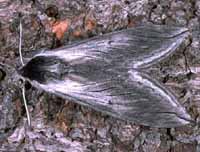 | The upperside of the forewing is dark grey to black with a
paler costa and pale area from the base to the wing's centre.
Prefered habitats include montane woodlands and mixed chaparral-type
vegetation. |
 |
The upperside of the forewing has a narrow black subterminal line
bordered by a white inverted V-shaped line on the outside, and a
black line running inwards from the apex of the wing.
It is most often found in montane woodlands and along streamcourses. |
Smerinthini Tribe:
 |
Pachysphinx modesta
WO,
the Modest Sphinx or Poplar Sphinx,
This large poplar/willow feeder possibly flies in Ada County.
They are a heavy bodied species.
|
 |
This one is quite similar to Pachysphinx modesta, with modesta
being smaller and darker.
There may be naturally occuring hybrids in Ada.
|
 |
The grey-blue eyespot of the hindwing gives this species its name.
Larvae feed on birches, willows, cherries and oaks.
The outer edge of the forewings is quite scalloped. |
 |
This small species is widespread and common and is likely present. This species ranges across North America.
The hindwings have a small blue eyespot ringed with black on a yellow background.
|
 |
If you have willows and poplars nearby, you've probably got populations of
the Cerisyi's Sphinx. The hindwings are quite striking. |
Macroglossinae subfamily
Dilophonotini tribe
 |
Hemaris diffinis USGS,
the Snowberry Clearwing or Bumblebee Moth
This day flying moth
is widely distributed in Idaho.
I suspect I will get reports from Ada County. |
Macroglossini tribe
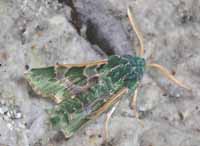 |
Arctonotus lucidus
USGS, the Pacific Green
Sphinx Moth or Bear Sphinx The Pacific Green
Sphinx Moth or Bear Sphinx tends to be an early spring flier, on the wing in the early
evening. It comes to lights at night. |
 |
Hyles gallii
WO,
the Bedstraw Hawk Moth or Gallium Sphinx
This species is not officially reported from Ada County; however, if
you have Gallium or Epilobium, you probably have
populations of this species. |
 |
Hyles lineata
USGS, the White-lined Sphinx
This species is very widespread. It can be seen flying during the day,
into the evening and also at night.
The highly variable larvae are often found in people's gardens. |
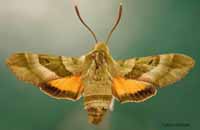 |
This day flier is officially reported from Ada County,
It flies from April-June, prefering oak woodland and pine-oak woodland in
foothills. Moths nectar at a variety of flowers in the afternoon.
|
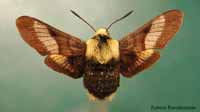 |
This day flier is not officially reported from Ada, but it has
been found to the north, east, south and west in meadows near
coniferous forests. |
|
|
Enjoy some of nature's wonderments, giant silk moth cocoons.
These cocoons are for sale winter and fall. Beautiful Saturniidae moths will emerge the following spring and summer.
Read Actias luna rearing article.
Additional online help available.
Eggs of many North American species are offered during the spring and summer. Occasionally
summer Actias luna and summer Antheraea polyphemus cocoons are available. Shipping to US destinations is done
from with in the US.
Use your browser "Back" button to return to the previous page.
This page is brought to you by
Bill Oehlke and the
WLSS. Pages are on space rented from Bizland. If you would like
to become a "Patron of the Sphingidae Site", contact Bill.
Please send sightings/images to Bill. I will do my best to respond to
requests for identification help.
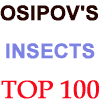 | 
Show appreciation for this site by clicking on flashing butterfly to the left.
The link will take you to a page with links to many insect sites. |


